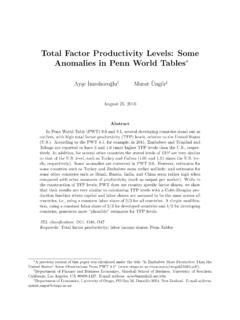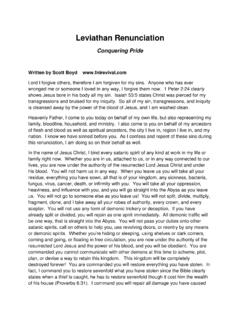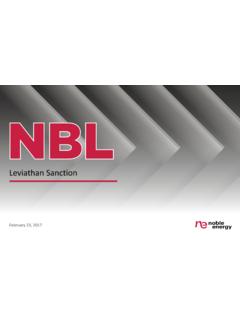Transcription of From Sea Battles to String-Puppets: Leviathan, Creation ...
1 From Sea Battles to string -Puppets: leviathan , Creation and Theodicy in the Book of Job Jesse Graham University of Virginia in press, Amalgam: The Virginia Interdisciplinary Review Yahweh's answer to Job has been the source of countless debates and critical re-readings over the centuries, and nothing has perplexed scholars as much as the fact that, instead of ending with an accounting for His apparent injustices, Yahweh ends with a lengthy poetic description of the sea monster leviathan . It seems a noble irrelevance, as George Bernard Shaw famously dismissed it,1 and the reader is both drawn to the passage's majesty and repelled by its obscurity.
2 In the following pages I will present a new reading of this passage, based on Job's uses of Rahab and leviathan and their roots in ancient Canaanite and Mesopotamian texts. It is my contention that these uses in Job represent not just leftover references to earlier tales, but rather deliberate reworkings of the chaoskampf myth into a radical new formulation of the problem of suffering in absolute monotheism. I will first examine the ancient sources of Rahab and leviathan , highlighting the Biblical parallels. I will then trace ways in which the Biblical uses fail to cohere with the ancient traditions, culminating in a more detailed look at Job's innovative treatment of the sea monster I.
3 Ancient Near Eastern Sources Before digging down to the ancient texts, it is important to clarify the identity of the figures we wish to excavate: Rahab and leviathan are, simply put, two different names for a serpent-like sea creature which Yahweh is variously said to have cut into pieces (Isa. 51:9),3. crushed like a carcass (Ps. 89:10), struck down with understanding (Job 26:12), punished (Isa. 27:1), crushed the heads of (Ps. 74:14), and formed to sport in the sea (Ps. 104:26). I largely 1. Wolfers, 474. 2. This paper will leave untreated the prose prologue and epilogue of the book of Job, mainly because they contain no reference to (or direct bearing on) Rahab or leviathan , but also because I follow Levenson (154) in seeing these passages as the work of a different author.
4 The text I deal with begins with Job cursing his own birth and ends with his repentance in dust and ashes. 3. All biblical references are to the New Revised Standard Version (NRSV) translation, except where otherwise noted. 2. follow John Day in treating the two as alternative names for the same creature Rahab (Job 26:13) and leviathan (Isa. 27:1) are both names given to the twisting serpent 4 with the important qualification that each word has its own history, and only leviathan 's (ltn., Lotan, Litan) has been successfully traced to ancient Canaanite texts, most notably the Ugaritic narrative poem known as the Baal Cycle. In the Ugaritic stories, the storm god Baal is delivered the following message by his foe Mot (Death): When you killed Litan,5 the Fleeing Serpent, Annihilated the Twisty Serpent, The Potentate with Seven Heads, The heavens grew hot, they withered.
5 6 Here we see many descriptive similarities with the Biblical leviathan , from the many heads in Ps. 74:14 to both fleeing serpent and twisting serpent in Isa. 27:1 (Job 26:13. also refers to the slaying of a fleeing serpent, this time called Rahab). The stories behind both leviathan and Rahab find dramatic parallel in another passage from the Baal cycle, in which Baal's beloved Anat speaks of her many conquests: Surely I. fought Yamm [ym, sea], the Beloved of El, Surely I finished off River, the Great God, Surely I. bound Tunnan [tnn, dragon] and destroyed him. I fought the Twisty Serpent, The Potentate with Seven Heads. 7 Besides containing much of the account of Litan (ascribed to Baal) quoted above, Anat's speech is useful for our purposes because it describes both a battle with the sea and a battle with a sea dragon in the same breath; as we'll see with Tiamat below, the personifications of primordial chaos often blur between sea and dragon, partly due to the fluidity between the root words and their employment (in its discussion of Tannin/Tunnan, the Dictionary of Deities and Demons in the Bible asks, are tnn, ltn and ym separate monsters or 4.)
6 Day, 39. 5. This is the same text that Heidel describes to be from Ras Shamra (107). He translates the name Lotan but the root ltn. is the same, which Day (4) shows to be the source of the name leviathan . 6. Parker, 141. Binger makes the case that here, as elsewhere in the story, the true dragon-slayer is Baal's beloved Anat. 7. Parker, 111. 3. different names/epithets for the same being? ).8 Anat claims she bound Tunnan before destroying him, echoing the omnipresent ancient Near Eastern myth of the binding of the waters;. as we'll see below, Job's monsters have been bound as well, but crucially have not yet been destroyed. Anat has a great propensity for monster-slaying, and she is later depicted spreading the remains of slain Mot (Death) as fertilizer for the next season's This is echoed in Ps.
7 74:14, which says Yahweh gave leviathan as food for the people/creatures of the wilderness (manna for the Israelites?); in both texts, the original battle of Creation is linked with the yearly Creation of food. The Mesopotamian epic Enuma Elish describes the slaying of sea-goddess Tiamat by the storm god Marduk, in a Creation battle most often associated with Genesis 1 due to the following passage: The Lord rested, and inspected her corpse. He divided the monstrous shape and created marvels (from it). He sliced her in half like a fish for drying: half of her he put up to roof the sky, drew a bolt across and made a guard hold it. 10 The battle between Marduk and Tiamat was central to the notion of chaoskampf, the emerging pattern of stories describing a battle between a god and the sea that led from chaos to Creation .
8 Leaving aside the ongoing debate about whether or not each Biblical instance necessarily implies a Creation story, the slaying of Tiamat holds many parallels with the Biblical Rahab and leviathan . For instance, Ps. 89:10 tells Yahweh You crushed Rahab like a carcass; you scattered your enemies with your mighty arm, . while Marduk threw down [Tiamat's] corpse he broke up her regiments; her assembly was scattered. 11 Tiamat's defeat is followed by the submission of her allies to Marduk: Then the gods her helpers, who had marched at her side, Began to tremble They were thrown into the net 8. DDD, 1581. 9. Coogan, Stories from Ancient Canaan, 112.
9 10. Dalley, 254-5. 11. Ibid., 253. 4. and sat there ensnared. They cowered back, filled with woe. 12 Job 9:13 contains the similar allusion God will not turn back his anger; the helpers of Rahab bowed beneath him. Marduk is said to have pierced Tiamat's belly and sliced her in half like a fish for drying, 13 whereas Yahweh is later reminded, Awake, as in days of old, the generations of long ago! Was it not you who cut Rahab in pieces, who pierced the dragon? (Isa. 51:9). Although we've just seen four striking parallels between Tiamat and Rahab, some scholars continue to rankle at the linkage of the sea-goddess with a sea dragon. However, as Heidel notes in his account of the debate,14.
10 Tiamat is portrayed as both sea and dragon in the art and literature of ancient Mesopotamia, and her attempt to devour Marduk eat or engulf? highlights an ambiguity that carriers over to the Biblical texts. Turning ahead for a moment to our focal text, we can see that Yahweh's answer to Job has its roots firmly in the very parallels we've seen between Biblical and other ancient Near Eastern treatments of sea creatures. As David Wolfers first pointed out,15 many of Yahweh's mocking questions to Job in 41:1-816 contain references to His (and Marduk's, Baal's, Anat's, etc.) own Battles . The references to catching leviathan with a fishhook (41:1), harpoons or fishing spears (41:7) correspond to the piercing of dragons we've seen in Isa.
















